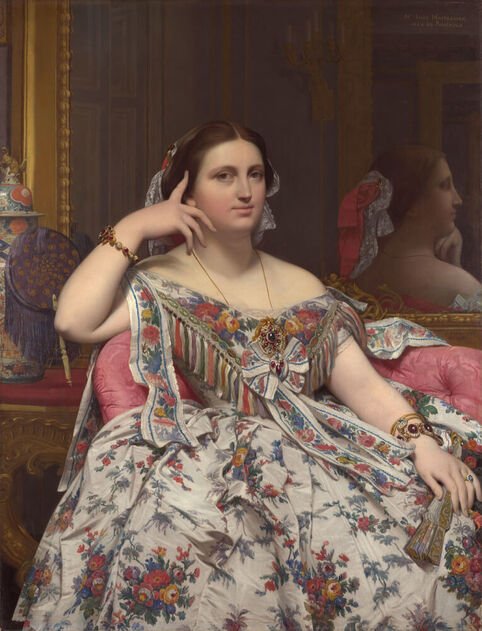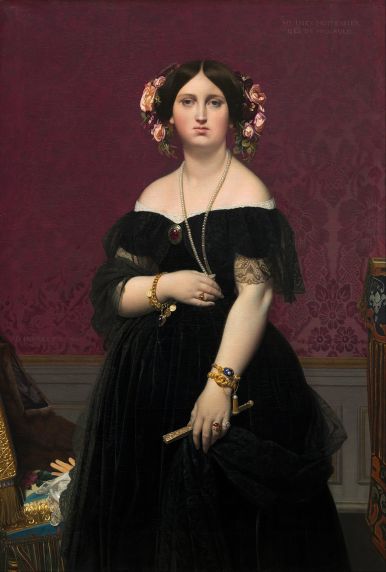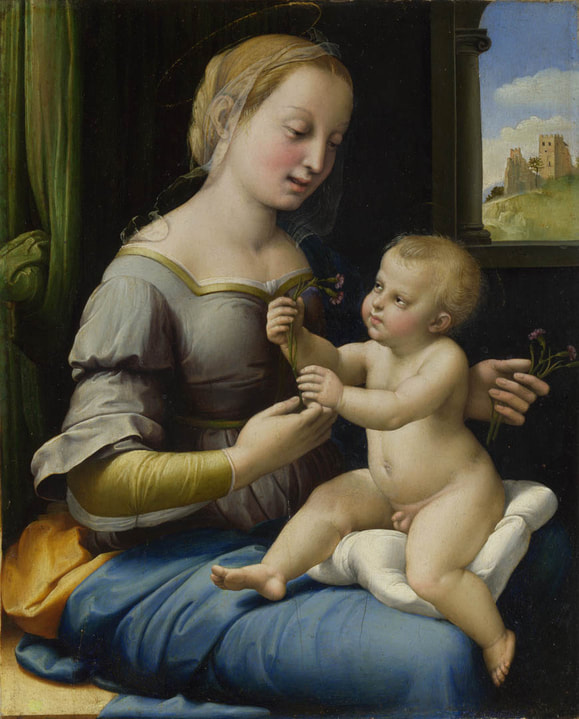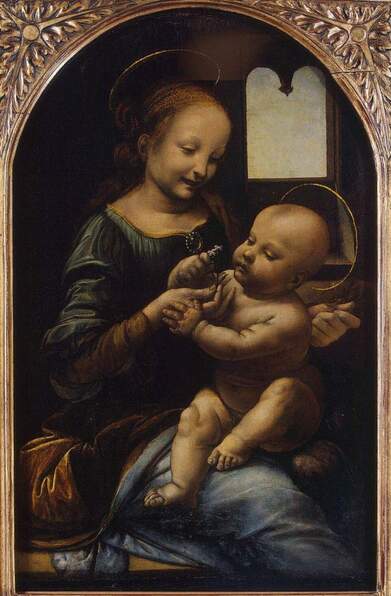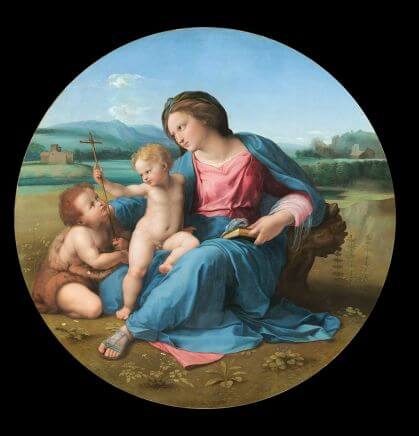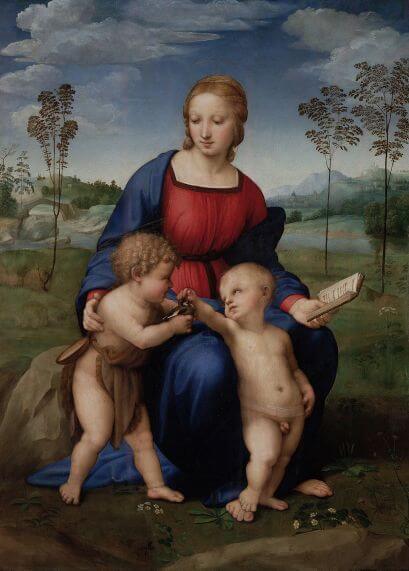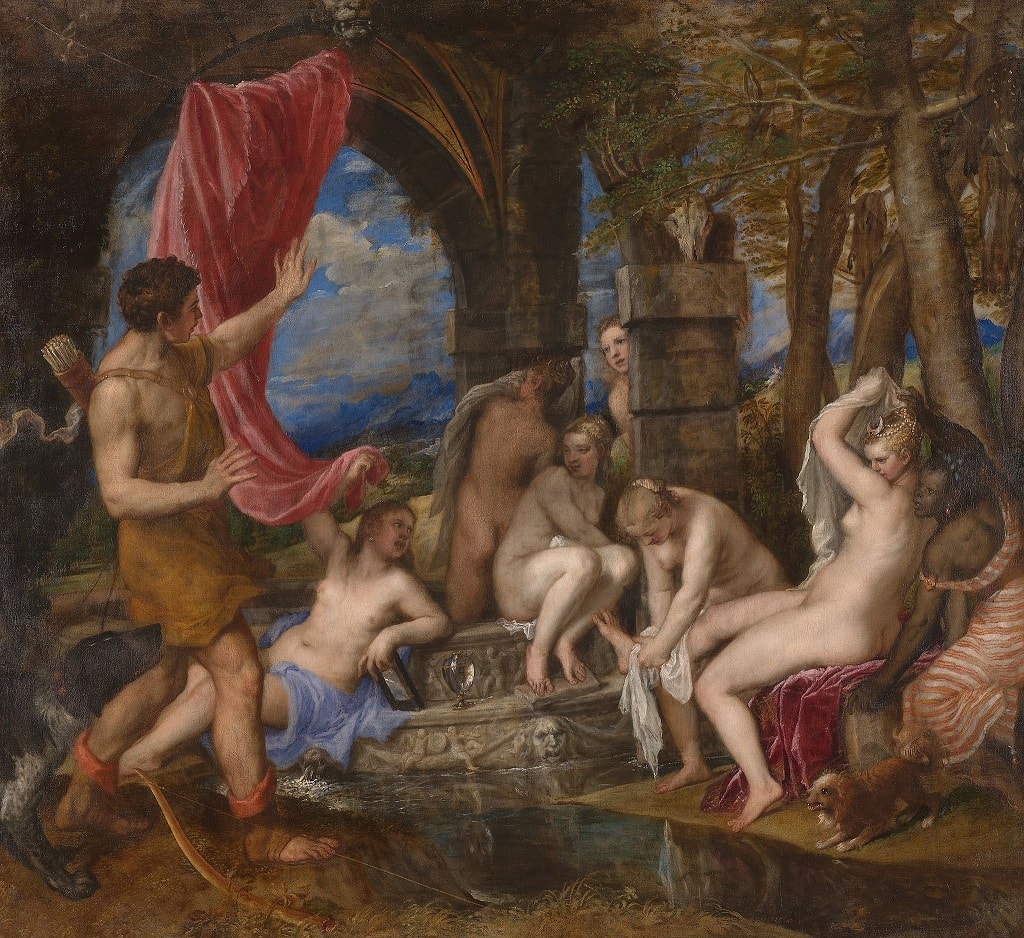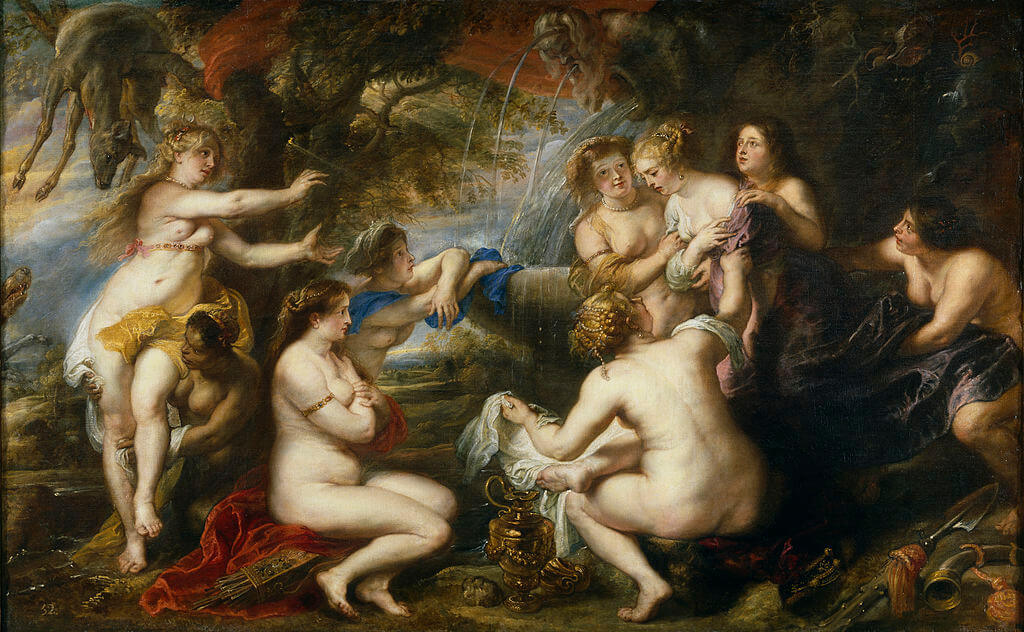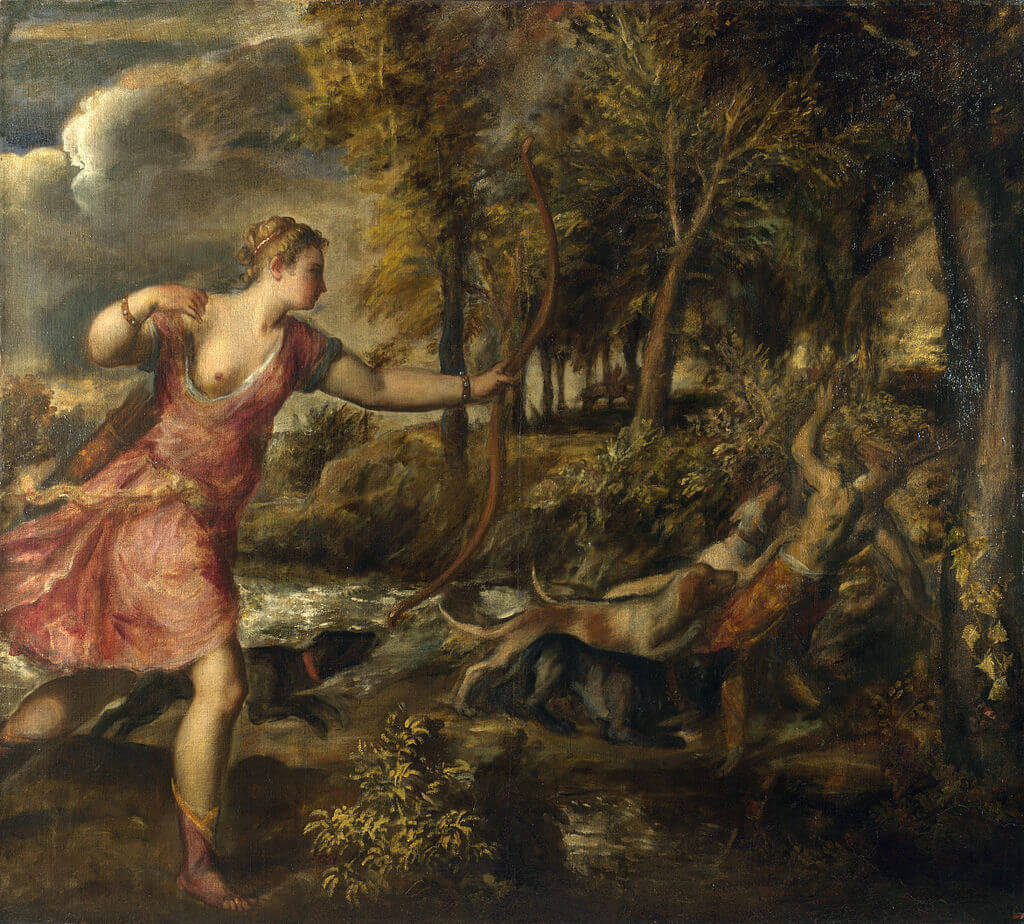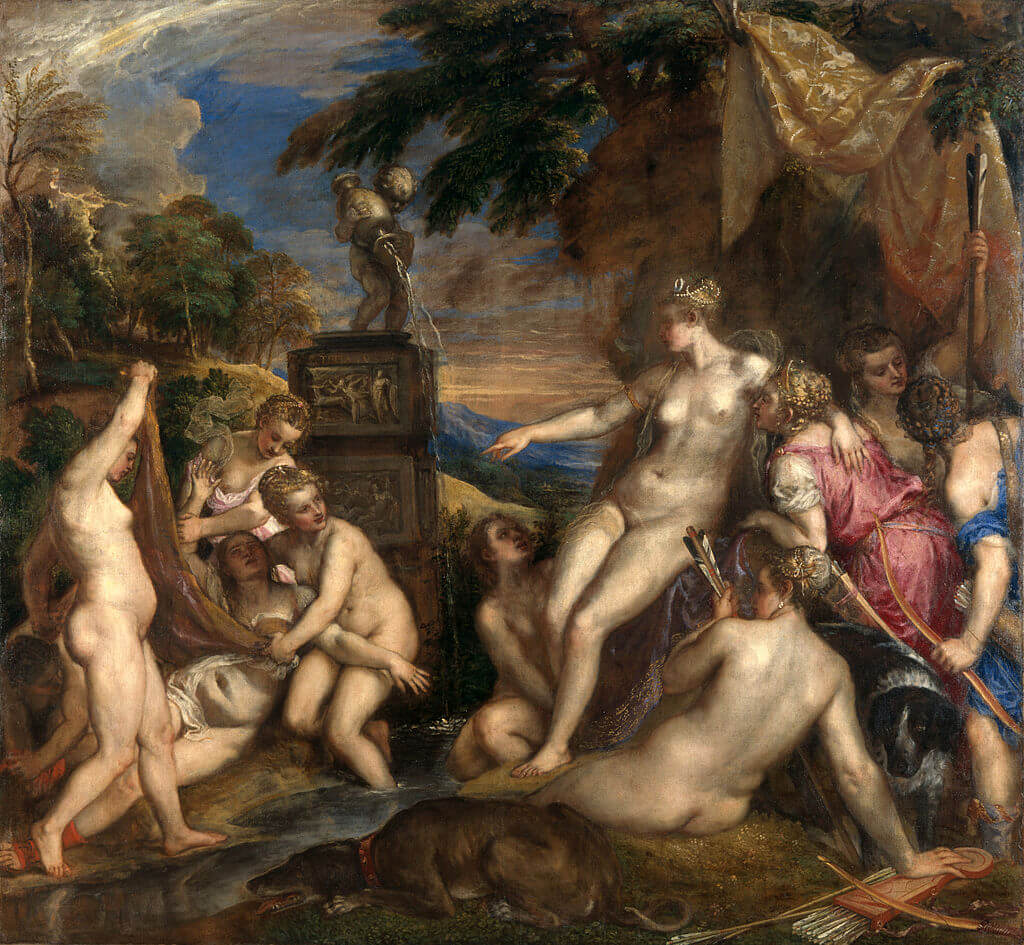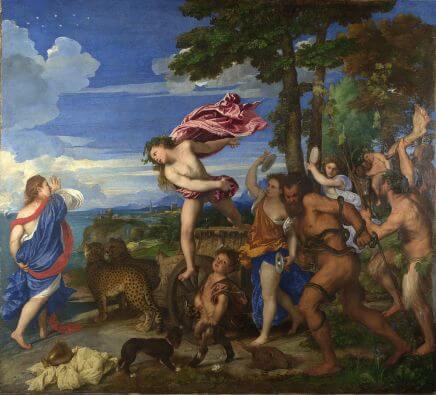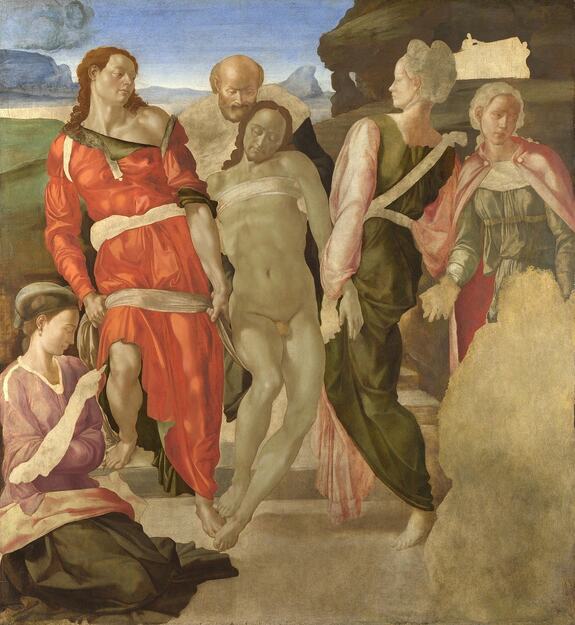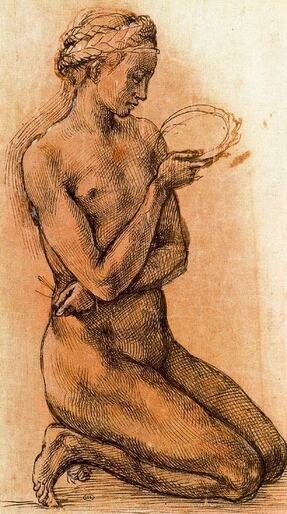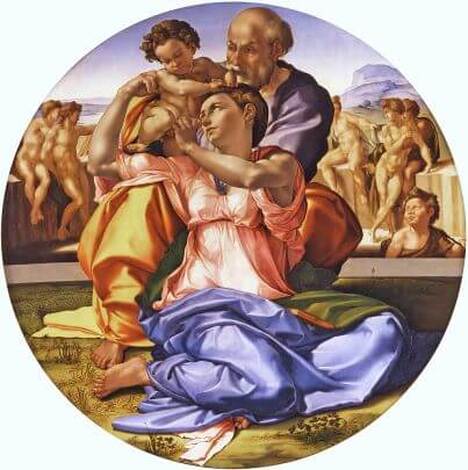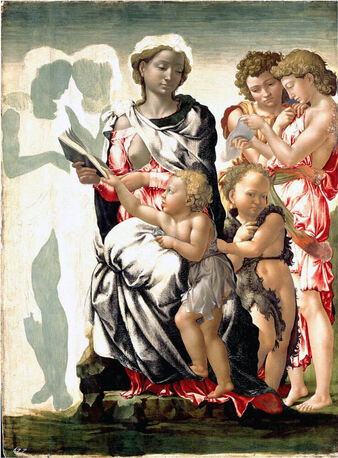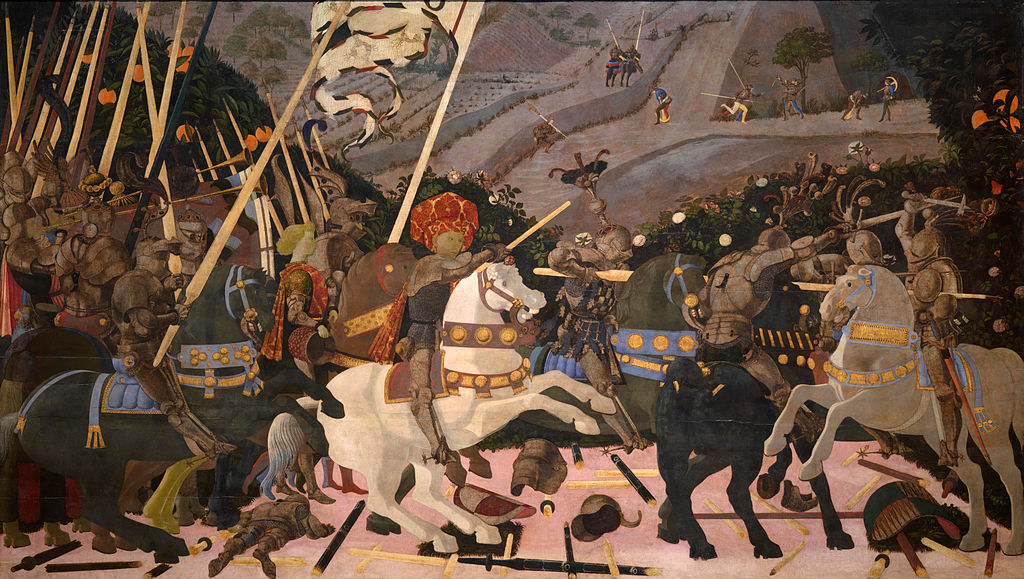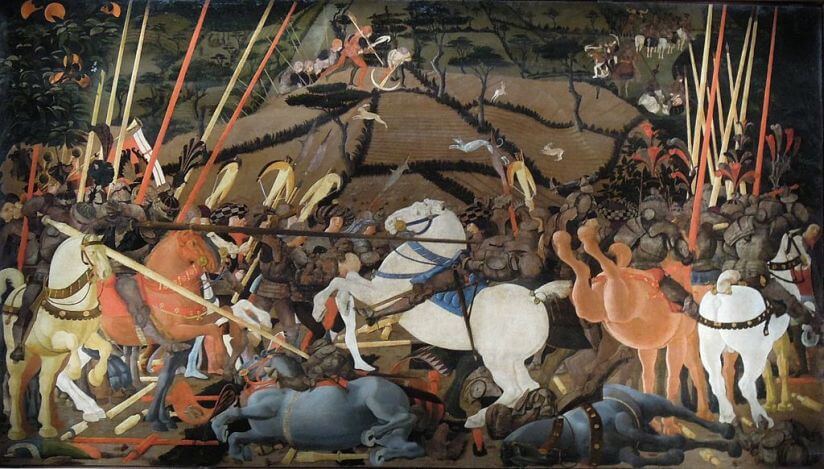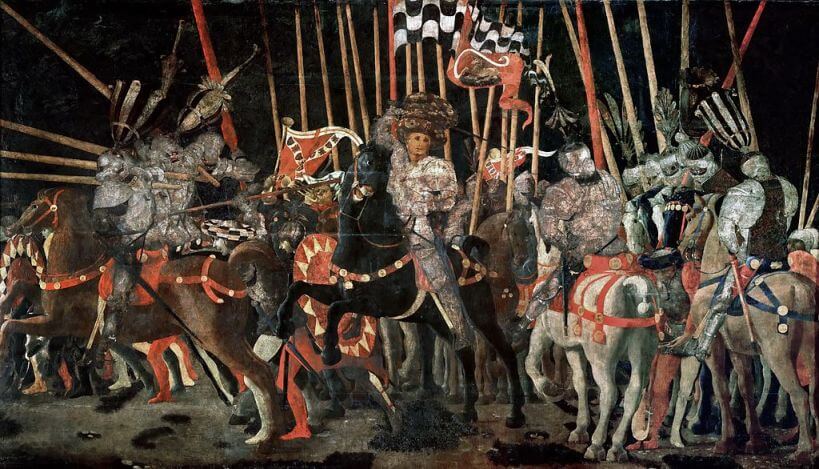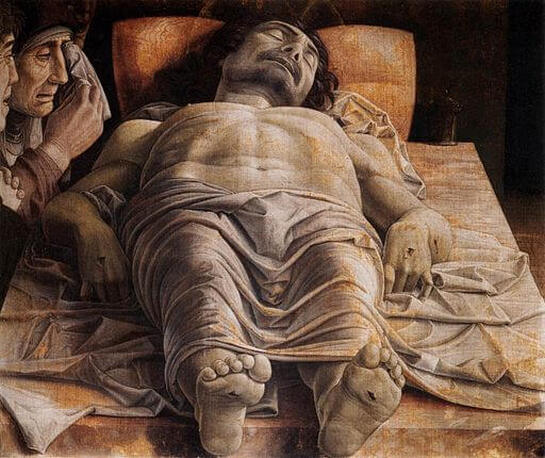|
Where? Room 45 of the National Gallery
When? 1856 Commissioned by? Paul Sigisbert Moitessier, the husband of Madame Moitessier. What do you see? Madame Moitessier is seated on a decorated sofa, also referred to as a canapé. She is wearing a large colorful silk dress with flower patterns. She probably wears a farthingale under her dress, which allows the bottom part of the dress to keep its circular shape. She is looking a bit sensual. For example, look at the blush on her cheeks. Her right hand is casually placed against the side of her head as was often done with Greek statues and she is holding a folding fan in her left hand. You can see the opulence in this painting. Madame Moitessier is wearing expensive bracelets, a ring, a necklace, decorated with various rubies. On the left, you can see a richly decorated screen fan and an expensive vase. Ingres believed that to paint a portrait you have to study the person from all angles and understand all her sides. This is reflected in the mirror that he included in the painting, which shows another side of Madame Moitessier (although it seems unlikely that this mirror is in the correct angle). This side shows her more naturally, with less jewelry. You can also see a candle tree in the mirror. Backstory: Ingres started with this painting around 1847, but only completed it in 1856 when he was 76 years old. He first got the invitation to paint a portrait of Madame Moitessier in 1844, but he refused that assignment as he was focused on mythological paintings. However, when he later met her, he changed his mind as he was very impressed by her looks which made him remember of Juno (the so-called Junoesque look, which means that she looked beautiful and dignified at the same time, just like the goddess Juno). Who is Madame Moitessier? Marie-Clotilde-Ines Moitessier (1821–1897) was the wife of Paul Sigisbert Moitessier, a wealthy banker and merchant. She was also known by her maiden name De Foucauld, which you can see by the inscription at the top right of this painting. Madame Moitessier was also the aunt of Charles de Foucauld, a famous French priest who was beatified by the Pope in 2005. Another portrait of Madame Moitessier: In 1851, Ingres painted another portrait of Madame Moitessier that is currently on display in the National Gallery of Art in Washington, D.C. He painted this second portrait while he had not finished the first one yet.
Who is Ingres? Jean-Auguste-Dominique Ingres (1780-1867) was born in Montauban, in the southwest of France. He was one of the primary Neoclassical painters. He considered himself to be a history painter but also painted quite some portraits during his career. Especially early in his career, he painted portraits to sustain himself. Interestingly, nowadays he is famous for the portraits that he painted.
His perfectionism may cause part of this fame. He found it very difficult to complete portraits, and he often got very frustrated and overwhelmed by these portrait assignments. A large part of his frustration came from the fact that the richer women that wanted a portrait could not hold their pose for an extended period of time. They tended to stand up and look at the painting and change the position of their dress and jewelry while he was painting them. In the end, however, he delivered stunning portraits. Fun fact: Ingres started some initial drawings for this painting in 1844. The idea was the Madame Moitessier was sitting with her daughter Catherine at her knee. Ingres, however, became severely frustrated during this process, partly because he found the daughter of Madame Moitessier very difficult to handle. After a few years, he decided that he should eliminate the daughter from this project, though that did not speed up the process. In 1849, the wife of Ingres died and he decided to stop his work on this painting. Only in 1852, after he remarried, he continued his work on this painting to ultimately finish it in 1856. Interested in a copy for yourself? Poster
0 Comments
Where? Room 60 of the National Gallery
When? 1506-1508 Commissioned by? Probably the Oddi family, a prominent family from Perugia. What do you see? The young Virgin Mary is sitting on a yellow-brown bench with Baby Jesus on her lap and you can see the faint halos above their heads. Mary looks at Jesus and is playing with him. She holds two flowers in her left hand and in her right hand she holds another flower which Baby Jesus is examining. The flowers are identified as pink carnations (also referred to as pinks). Jesus is sitting on top of a white cushion and is absorbed by the flower. Mary is wearing a greyish dress with a belt, and her dress is yellow-gold and white on the top and on her right arm. She also has a blue robe around her legs, and this robe also covers her left side including her shoulder (this is a bit more difficult to see as this blue has darkened a bit over time). She is also wearing a transparent veil in her hair that falls over her shoulders. On the top right, you can look through the window and observe the hills, a castle, and the blue skies. On the left, you can see a green bedcurtain. Note also the quality of Raphael’s work. He carefully combined light and shadow to paint the folds in Mary’s dress and the bodies of Mary and Jesus. His delicate depiction of the translucent veil is also of very high quality. Backstory: This painting is also referred to as La Madonna dei Garofani (which is Italian for ‘The Madonna of the Carnation’) or the Northumberland Madonna (after its previous owner). It is heavily inspired by the Benois Madonna painting by Leonardo da Vinci which can be admired in the Hermitage Museum in Saint Petersburg. The Madonna of the Pinks is a small painting (27.9 cm × 22.4 cm or 11.0 in × 8.8 in), and it may have been created for the nun Maddalena degli Oddi to bring with her wherever she went as an aid for prayer. There are many copies of this painting which are clearly not made by Raphael. However, in 1992, the Duke of Northumberland agreed that the version he owned would be displayed in the National Gallery and could be cleaned and investigated using infra-red reflectography. The investigation concluded that this painting was the original made by Raphael (though some experts still doubt this attribution nowadays). The painting is still in excellent condition, but some cracks can be seen. For example, in the bottom middle, there is a clear vertical crack that runs up through the right leg of Jesus and the back of Mary’s right hand.
Symbolism: The main symbol in this painting is the pink carnation (or pink). According to a legend, this flower first appeared on earth from the tears of Mary that fell on the cross at the crucifixion of Jesus. Pink carnations symbolize the divine love of Mary towards Baby Jesus. They are also seen as a symbol of divine protection and marriage. The pink carnation is still a popular flower for Mother’s Day in the U.S.
The scene of Mary and Jesus is situated in a bedchamber, which is a symbol of maternity. Furthermore, the castle towers seem ruined, which is a symbol of the demise of the pagan world after the birth of Jesus. Who is Raphael? Raffaello Sanzio da Urbino (1483-1520) was born in Urbino in Italy. Together with Leonardo da Vinci and Michelangelo, he is considered to be one of the three prime painters of his time. He moved to Florence in 1504 where he created this painting. During that time he primarily created Madonnas and portraits. In 1508 Raphael moved to Rome to work for the Pope. Raphael often included the Madonna theme in his paintings. For example, the Alba Madonna in the National Gallery of Art in Washington, DC shows Mary, Jesus, and Saint John. Another example is the Madonna of the Goldfinch in the Uffizi Museum in Florence, which also shows Mary, Jesus, and Saint John.
Fun fact: The painting was acquired by the National Gallery in 2004 for almost ₤35 million (which was equivalent to about $60 million at that time). Given its small size, this painting became the most expensive painting ever sold per square centimeter. The acquisition of this painting was not easy, however, as the National Gallery and the J. Paul Getty Museum in Los Angeles were fighting a public battle over this painting.
Both museums were willing to offer an equal amount of money for the painting. However, the National Gallery came up with some very favorable tax advantages for the seller, who was the Duke of Northumberland and thus lived in England. Interestingly, when the painting was discovered in the collection of the Duke in 1991, it was considered a copy of Raphael’s original painting that was missing and only valued at ₤6000.
Where? Room 6 of the National Gallery
When? 1556-1559 Commissioned by? King Philip II of Spain What do you see? On the left, the hunter Actaeon arrives together with his dog to a bathing scene of the goddess Diana and her five nymphs and one slave. Actaeon is wearing his arrows on his back, and his bow fell on the ground. The nymph on the left draws back the curtain to reveal that Actaeon is looking at the naked Diana at the other side of a small stream. She is sitting on the right, next to a fountain, on the red cloth and is washed by one of her nymphs. Diana wears a diadem with a crescent moon. Diana is surprised by the arrival of Actaeon, and the dark-skinned slave behind her helps to cover her identity by putting a cloth in front of her face. Next to Diana, you can see one of her lapdogs who is barking at the dog of Actaeon. Above the knees of Diana, you can see a skull of a deer on top of a pillar, which is part of an arched canopy. To the right of the skull, you can see a deerskin hanging in the tree and to the right of that hangs another deerskin at the edge of the painting. In the background, above Diana, you can see a very small figure of a person dressed in white who is chasing a deer. This person is probably another depiction of Diana while she is hunting. There are various other details in the paintings. For example, in the middle of the painting, you can see a vase and a mirror. You can also see that the water enters the stream through the mouth of one of the carved lion heads below the nymph on the left. Backstory: This painting is part of a series of seven mythological paintings that Titian painted for King Philip II of Spain. Titian entitled this painting as Diana at the Fountain Surprised by Actaeon. Titian based this painting on the third book of the Metamorphosis by Ovid (Amazon link to the book). The story goes: “While Titania is bathing there... Cadmus’s grandson [Actaeon]… strays with aimless steps through the strange wood, and enters the sacred grove… As soon as he reaches the cave mouth dampened by the fountain, the naked nymphs, seeing a man’s face, beat at their breasts and filling the whole wood with their sudden outcry, crowd round Diana to hide her with their bodies... Diana’s face, seen there, while she herself was naked, was the colour of clouds stained by the opposing shafts of sun... She [Diana] caught up a handful of the water that she did have, and threw it in the man’s face... Without more threats, she gave the horns of a mature stag to the head she had sprinkled, lengthening his neck, making his ear-tips pointed, changing feet for hands, long legs for arms, and covering his body with a dappled hide... They [the dogs of Actaeon] surround him on every side, sinking their jaws into his flesh, tearing their master to pieces in the deceptive shape of the deer.” Symbolism: The skull of the stag (a male deer) with antlers refers to the fate that awaits Actaeon. After having seen Diana naked, she changes him into a male deer and was killed by his 50 hounds. The skull and the deer skins also refer to Diana as the goddess of hunting. The diadem with the crescent moon is one of the important attributes of Diana and also refers to her being the goddess of the moon. The top of the dress of the slave is in the form of a crescent moon, which is also a reference to Diana. Who is Diana? Diana (comparable to Artemis in Greek mythology) is the daughter of Jupiter (Zeus in Greek mythology; god of the sky and thunder) and Latona. She was also the twin sister of the God Jupiter. Diana is the goddess of hunting and wild animals. She could communicate with animals. She was also a virgin goddess who promised never to marry a man. Diana’s story has been a popular subject for artists, and she has been painted by, among others, Rubens and Rembrandt. For example, below is the painting Diana and Callisto by Peter Paul Rubens, which is on display in the Prado Museum.
Who is Actaeon? Actaeon was a famous hunter. He was trained by the centaur (half human, half horse) Chiron. He is best known for his cruel death as described above. The reason that Actaeon is killed is either that he claimed to be a better hunter than Diana or because of his sexual interest in her.
After Actaeon was transformed into a stag by Diana, he was killed by his own dogs who did not recognize him anymore. After the dogs killed him, they went back to Chiron to search their master Actaeon as they could not find him. Chiron, who knew what happened, created an image of Actaeon to help them in their grief. Who is Titian? Tiziano Vecelli (or Vecellio) was born around 1489 and died in 1576. He was the most important member of the Venetian School of Painters. He was an all-round painter and was able to paint superb portraits, landscapes, religious and classical paintings. A large number of paintings of Titian have survived of which several can be seen in the National Gallery in London. For example, two other famous paintings of Titian are The Death of Actaeon and Diana and Callisto, which are both also on display in the National Gallery. Just like Diana and Actaeon, these paintings were also a part of the series of seven mythological paintings that Titian created for King Philip II. Another painting in the National Gallery is Bacchus and Ariadne.
Fun fact: This painting is jointly owned by the National Gallery in London and the National Gallery of Scotland. The painting will rotate every five years between both museums. It was bought by both museums, after an extensive public campaign to raise the money, for a sum of $70.6 million. One of the reasons for the high price of this painting is that the painting was well-preserved over time. One exception may be that the deer skins hanging in the trees are hard to see. The reason is that the copper color that was used here changes into brown after extensive exposure to light.
The painting is currently listed in the top 100 of most expensive paintings ever. Two other paintings of Titian are also listed in this top 100. One of those two paintings is Diana and Callisto, which was bought by the National Gallery in London and the National Gallery of Scotland through a similar construction in 2013 for a total of $71.7 million.
Where? Room 20 of the National Gallery
When? Probably 1500-1501 Commissioned by? Possibly for the church of Sant'Agostino in Rome
What do you see? This unfinished painting shows how the lifeless body of Jesus is carried up some steps to be put in his tomb. The beautifully-painted body of Jesus has already been washed after the crucifixion as there is no sign of blood on his hands and feet and the crown of thorns has been removed. The tomb was owned by Joseph of Arimathea, who is the bearded man standing behind Jesus. Two broad linen bands support the body of Jesus. The person to the left of Jesus in the magnificent red-orange robe is Saint John, and the person on the right is probably Nicodemus.
Backstory: This painting provides a good look at how Michelangelo worked on a painting. For this painting, he first created a drawing and based on that he painted the different parts and colors one by one. Because this painting is unfinished, there has been quite some uncertainty and debate about this painting over the years.
There are different theories about when he painted this, for who, and whether it is a painting from Michelangelo or whether the painting or parts of it should be attributed to some of his students. But there is also uncertainty about who is who in the painting. For example, it is not completely clear who is Mary Magdalene and who is Mary Salome in the picture, and there is also debate whether the person directly to the right of Jesus is indeed Nicodemus (or maybe a woman instead). What is the entombment? The burial of Jesus is described in the four Gospels and is referred to in the letter of Paul to the Corinthians. The Gospels tell somewhat different stories on the burial of Jesus. In short, Joseph of Arimathea asked for the body of Jesus after the crucifixion to bury it in accordance with the Jewish law which stated that a body could not be left exposed during the night. According to the Gospel of John, he got help from Nicodemus. Mary Magdalene and the Virgin Mary were also present at the burial. The body of Jesus was washed, wrapped in linen, and spices were put on the linen. After that, the body of Jesus was put in a tomb cut out of rock and a big stone was rolled in front of the entrance. Why the entombment? While it is not entirely clear who commissioned this painting, the theme of the entombment may be a great one for an altarpiece. When people in a Catholic Mass kneel in front of the altar and look up, they would see the body of Christ. This view would remind them that the ritual bread that they eat and the wine that they drink during the Mass represents the body of Christ.
Who is Michelangelo? Michelangelo di Lodovico Buonarroti Simoni (1475-1564) was born in Caprese which is about 50 miles (or 80km) from Florence. However, he was raised from a young age in Florence. During his life, he kept going back and forth between Florence and Rome. He developed himself into one of the greatest artists of all time and was a great painter, sculptor, architect, and even a poet. Quite some work of Michelangelo has survived, but interestingly only three paintings have survived. Michelangelo is better known for his frescos and sculptures.
Fun fact: This is not the only work that Michelangelo did not finish. In fact, he was quite good at abandoning his works halfway. Another unfinished painting of him in the National Gallery (in Room 20) is The Virgin and Child with Saint John and Angels (also known as the Manchester Madonna). Yet another great example of his unfinished work is the series of unfinished sculptures in the Galleria Academica in Florence. There is only one completed painting by Michelangelo that survived, which is the Doni Tondo in the Uffizi Museum. Of course, he also finished various sculptures and frescos of which the most famous one is the ceiling of the Sistine Chapel in Rome. Other artists that were notorious for not finishing their paintings include Leonardo da Vinci and Parmigianino.
Where? Room 54 of the National Gallery
When? Between 1435 and 1460. The dating of this painting has been the subject of much debate, but most critics believe it is painted between 1435 and 1440. Commissioned by? Lionardo Bartolini Salimbeni, a rich Florentine man who had a strong commercial interest in the battle of San Romano. What do you see? This painting shows a scene from the battle of San Romano on June 1, 1432. This battle was fought between the Republic of Florence and the Republic of Lucca with its allies. The person in the middle with the big red and gold hat (instead of a helmet) is Niccolò da Tolentino, a Florentine general. His white horse is standing on its back feet, and Niccoló is attacking the soldier from the opposing army on the grey horse on the right. Niccoló holds a short stick in his right hand, which identifies him as a general. To the left of Niccoló, you can see a boy with blond hair who is holding Niccoló’s banner, which is decorated with ‘knots of Solomon” symbols. The battlefield is bounded by a thick layer of vegetation with growing oranges, pomegranates, and flowers. Behind the vegetation is the hilly Tuscan landscape with several soldiers spread around. The main feature of this painting may not be the battle, but the linear perspective that Uccello included in this painting through the arrangement of the lances, flags, and knights in the foreground. Look specifically at all the broken lances in the foreground which are arranged in such a way that the vertical lances all point in the direction of a single vanishing point at the top of the head of the white horse. Uccello was one of the first artists to introduce linear perspective to painting. This means that the lances, flags, people, etc. are portrayed in proper perspective. For example, the warrior on the white horse in the center is supposed to be equally tall as the dead warrior laying on the ground to the left of him (though it may not appear to be the case according to most viewers). Backstory: The battle of San Romano (a small place in Italy, near Lucca) was part of the war between the Republic of Florence and the Republic of Lucca with its allies from Genoa, Milan, and Siena. An important element of the war was about who would get access to the port of Pisa for trade. The battle of San Romano took place on June 1, 1432, and lasted less than a day. This battle was only a relatively minor battle, but the Florentines remembered it as a turning point in the war. This painting commemorates the Florentine victory in this battle, though Sienese sources disagree with this conclusion. The battle started by Florentine general Niccoló Tolentino being attacked after he was separated from most of his army when he was exploring the area. Tolentino and his small group of soldiers fought a brave fight and did not give up until another Florentine general, Micheletto Attendolo (who is at the center of the Louvre version of this battle), arrived at the battle scene with reinforcements. Attendolo and his army helped Florence to win this battle. The war dragged on for another year without a clear winner, and in the end, the war was settled through negotiations. Other versions of this painting? This painting is a part of a triptych (a work of art divided into three parts) made by Uccello. The three paintings represent different moments in the battle of San Romano. There are two alternative explanations about the order of the paintings. The simple explanation is that the three paintings represent the morning of the fight (the current version), the afternoon (the Uffizi version), and the evening (the Louvre version). A more popular alternative is that the current version represents the beginning of the battle with Niccoló da Tolentino. The Louvre version represents the arrival of Micheletto Attendolo and his army. The Uffizi version shows the last episode where Bernardino della Ciarda from the opposing army has been unhorsed. In both explanations, the current version of the painting will represent the painting on the left of the original triptych.
Who is Uccello? Paolo Uccello (1397-1475) was born as Paolo di Dono in Pratovecchio in Tuscany. In his teenage years, he was an apprentice of Lorenzo Ghiberti and later he got influenced by contemporaries such as Donatello, Brunelleschi, and Masaccio. He was named Uccello, which is Italian for ‘bird’, because he liked to paint birds. He developed strong scientific interests and was very interested in representing perspective in paintings, something that he and contemporary artists just introduced to painting. The appropriate use of linear perspective was often more important for Uccello than what the painting should represent.
In his paintings, he combines elements from the older Gothic tradition (the decorative parts) and the newer Renaissance movement (which introduced depth and perspective). The current painting is a good example of the combination of styles. The use of perspective represents the Renaissance component, while the Gothic component is visible in the attention Uccello paid to the details of the armors and all the patterns in this painting. Linear Perspective? Linear perspective was developed around 1420 by Brunelleschi. It was a completely new approach to represent space in paintings. The simplest idea of perspective is that the size of objects becomes smaller, the further away they are from the observer. Paintings with perspective have one or multiple vanishing points which help the painter to create perspective. Foreshortening is a specific form of perspective in which an illusionary trick is used to provide the idea of depth. A great example is when someone wants to paint a picture of a person laying with his feet towards you. To create the idea of depth, the painter will paint the feet of the person bigger than his head. The Lamentation of Christ by Mantegna is a great example of foreshortening. Note that the linear perspective in Uccello’s paintings is definitely not perfect, but it did help to create depth in two-dimensional paintings. His work served as an inspiration for many artists in the next generations who perfected his ideas about linear perspective in paintings.
Fun fact: You can see ten soldiers scattered across the rolling hills in the background. Seven of them are dressed in clown-like, colorful pants and seem to perform various training tasks. Three of them are archers and hold crossbows in their hands. You can see two of them loading the crossbow with their feet as that was a physically demanding job. Two other soldiers on horses are standing across the road. Some people say that these soldiers are sent from the battlefield by Niccoló da Tolentino to ask for backup, though they do not seem to be in a big hurry.
|
Categories
All
|
- Home
- Blog
-
Museums
- Alte Pinakothek
- Art Institute of Chicago
- Baltimore Museum of Art
- Barber Institute of Fine Arts
- Bargello
- Barnes Foundation
- British Museum
- Church of Sant’Anastasia
- Cleveland Museum of Art
- Courtauld Institute of Art
- Detroit Institute of Arts
- Frans Hals Museum
- Galleria Borghese
- Gallerie dell'Accademia
- Getty Museum
- Guggenheim
- Hermitage Museum
- Kunsthistorisches Museum
- Kunstmuseum Basel
- Legion of Honor Museum
- Louvre
- Mauritshuis
- Metropolitan Museum of Art
- Musee d’Orsay
- Museum of Fine Arts in Boston
- Museum of Modern Art
- National Gallery in London
- National Gallery of Art
- National Museum in Poznań
- Norton Simon Museum
- Ny Carlsberg Glyptotek
- Palace of Versailles
- Palazzo Pitti
- Palazzo Vecchio
- Petit Palais
- Philadelphia Museum of Art
- Prado
- Pushkin Museum
- Ravenna Art Museum
- Rijksmuseum
- San Diego Museum of Art
- Santa Maria delle Grazie
- St. Peter's Basilica
- Städel Museum
- Statens Museum for Kunst
- Tate Britain
- Tate Modern
- Timken Museum of Art
- Uffizi
- Vatican Museums
- Wallace Collection
-
Artists
- Altdorfer
- Anguissola
- Berlin Painter
- Bosch
- Botticelli
- Boucher
- Bronzino
- Bruegel the Elder
- Brunelleschi
- Cabanel
- Caillebotte
- Canova
- Caravaggio
- Carpeaux
- Cezanne
- Cimabue
- David
- Degas
- Delacroix
- De Maria
- Donatello
- El Greco
- Fontana
- Fra Angelico
- Fragonard
- Gauguin
- Gentileschi
- Gericault
- Gonzalez-Torres
- Goya
- Hals
- Hogarth
- Hokusai
- Ingres
- Leonardo da Vinci
- Lippi, Filippo
- Longhi, Barbara
- Lorrain
- Makovsky
- Manet
- Massys
- Matisse
- Merian
- Michelangelo
- Mochi
- Modigliani
- Monet
- Panini
- Parmigianino
- Perugino
- Picasso
- Pisanello
- Raphael
- Rembrandt
- Renoir
- Reynolds
- Rivera
- Rodin
- Rubens
- Scultori
- Seurat
- Steen
- Tintoretto
- Titian
- Toulouse-Lautrec
- Turner
- Uccello
- Van der Weyden
- Van Dyck
- Van Eyck
- Van Gogh
- Van Hemessen
- Vasari
- Velazquez
- Vermeer
- Veronese
- Vigée Le Brun
-
Locations
- Books
- About Us

